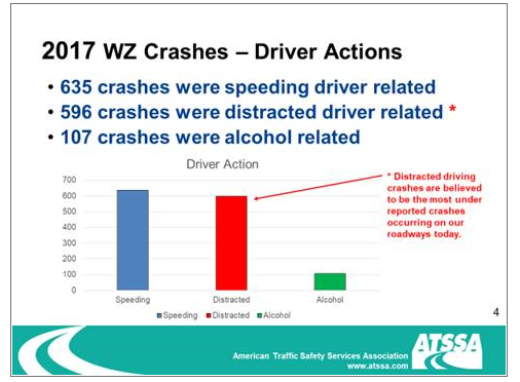When should we use flaggers with todays' risky driver behavior?

The MUTCD tells us who can do a flaggers’ job with specific qualifications, how he or she shall direct traffic with a stop/slow paddle, what to wear for high-visibility apparel, and where to stand, but the MUTCD does not tell us when to use flaggers under high-risk work zone conditions, where flagger fatalities typically occur. A flagger is not a traffic control device as per the definition. A flagger is a human, therefore, when to use flaggers falls under the jurisdiction of the Department of Labor and the Occupational Safety and Health Administration (OSHA). It’s up to OSHA to create new standards (or regulations) for when to use flaggers to promote Occupational Safety and Health.
My intrigue in this topic all began last August, when I attended ATSSA’s 2018 mid‐year meeting. More than 300 members and industry partners from across the United States came together in Williamsburg Virginia to discuss the future of the roadway safety industry.
In his opening remarks to the general session, Mr. Stephen C. Brich, Virginia DOT Commissioner remarked that “distracted drivers involved in motor vehicle crashes in Virginia is an epidemic, and safety is the number one issue we are facing today… we had two flaggers struck by distracted drivers in two districts in crashes that occurred just days apart”.
After the morning general session, Mr. David Rush, VDOT Work Zone Safety Program Manager spoke in more detail about the safety issues. He said, “No matter how many advanced warning signs you install, distracted drivers don’t see them, and they don’t slow down … and when they don’t see the signs, they don’t see the Flaggers either.”
These statements made by industry leaders at a national meeting are to be taken seriously. This compelled me to try and find an answer to the question – “under what conditions should we use flaggers with a stop/slow paddle”?
I read through pertinent sections of the MUTCD and I found one mandatory flagger standard- the wearing of high-visibility apparel. This is considered by the FHWA and OSHA as a feasible means to address the hazard, even though struck-by hazards in highway/road construction work zones are well recognized by the construction industry. The wearing of high-visibility apparel is required under OSHAs’ General Duty Clause to protect employees exposed to the danger of being struck by public and construction traffic while working in highway/road construction work zones. This is a regulation that can be enforced.
From time to time, OSHA will publish a safety recommendation. In 2001, the National Institute (NIOSHA) published a document titled “Measures to Prevent Worker Injuries from Vehicles and Equipment”. OSHAs’ recommendations are as follows;
“Avoid using flaggers whenever possible. Use alternative management systems such as lane shifts, portable Traffic signals, or remote signaling devices operated by workers away from the flow of traffic.”
The OSHA publication is not a regulation, it’s simply a recommendation and cannot be enforced. Since the publication in 2001, distracted drivers using smart phones have become an epidemic safety issue with a direct link to 4 to 5 (reported) flaggers being killed every year. It’s time for new regulations to address this issue to improve flagger safety and work Towards Zero Deaths.
One State regulator has taken OSHAs’ recommendation to the highest level, so that when to use flaggers can be enforced.
The Washington State Legislature created a new Administrative Code to promulgate (promote) occupational safety and health regulations. Code # (WAC) – 296-155-305 talks about signaling and when to use flaggers. Here is what it says;
(a) You must use flaggers when other reasonable traffic control methods will not adequately control traffic in the work zone
(b) If signs, Signals, and barricades do not provide necessary protection from traffic at work zones and construction sites on or adjacent to a highway or street, then you must use flaggers or other appropriate traffic controls
A new Federal Administrative Regulation will go a long way in helping industry professionals on when to use flaggers and saving flagger lives.
In continuing my research, I reviewed the regulations in Canada…
I found a regulation in the Province of British Columbia’s WorkSafe BC, Occupational Health and Safety Regulation (OHSR). The OHSR contains legal requirements that must be met by all workplaces under the inspectional jurisdiction of WorkSafe BC. In Part 18 Traffic Control, Item # 18.6 – Use of a traffic control person, it states;
(1) A traffic control person may be used only
- (a) if the use of signs and other traffic control devices and procedures alone cannot provide effective traffic control, or
- (b) during emergency or brief duration work if it is not practicable to control traffic with signs and other devices and procedures.
If Washington State and the Province of British Columbia find it necessary to create a regulation for when to use flaggers, then shouldn’t there be a regulation at the Federal level as well?
On March 28th, I submitted a formal “request for change” to the FHWA – MUTCD Team to include when to use flaggers with a copy to the OSHA Directorate. I am looking forward to getting an answer back, but it may take several months.
I’ll keep everyone updated on what the MUTCD Team intends to do about this!
Peter Vieveen
Founder and Chairman
